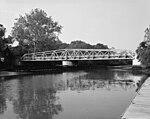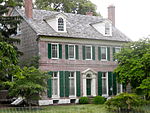Repaupo, New Jersey
Logan Township, New JerseyNew Jersey geography stubsUnincorporated communities in Gloucester County, New JerseyUnincorporated communities in New Jersey
Repaupo is an unincorporated community located within Logan Township in Gloucester County, New Jersey, United States. Repaupo can be accessed by Interstate 295/U.S. Route 130, via exit 14. The community was settled in the 17th century by Swedes from the former colony of New Sweden. Men such as Andreas Anderson, former trumpeter to Governor Printz, was one of the prominent settlers.
Excerpt from the Wikipedia article Repaupo, New Jersey (License: CC BY-SA 3.0, Authors).Repaupo, New Jersey
Asbury Station Road, Logan Township
Geographical coordinates (GPS) Address Nearby Places Show on map
Geographical coordinates (GPS)
| Latitude | Longitude |
|---|---|
| N 39.799722222222 ° | E -75.298888888889 ° |
Address
Repaupo Volunteer Fire and Rescue
Asbury Station Road
08066 Logan Township
New Jersey, United States
Open on Google Maps





